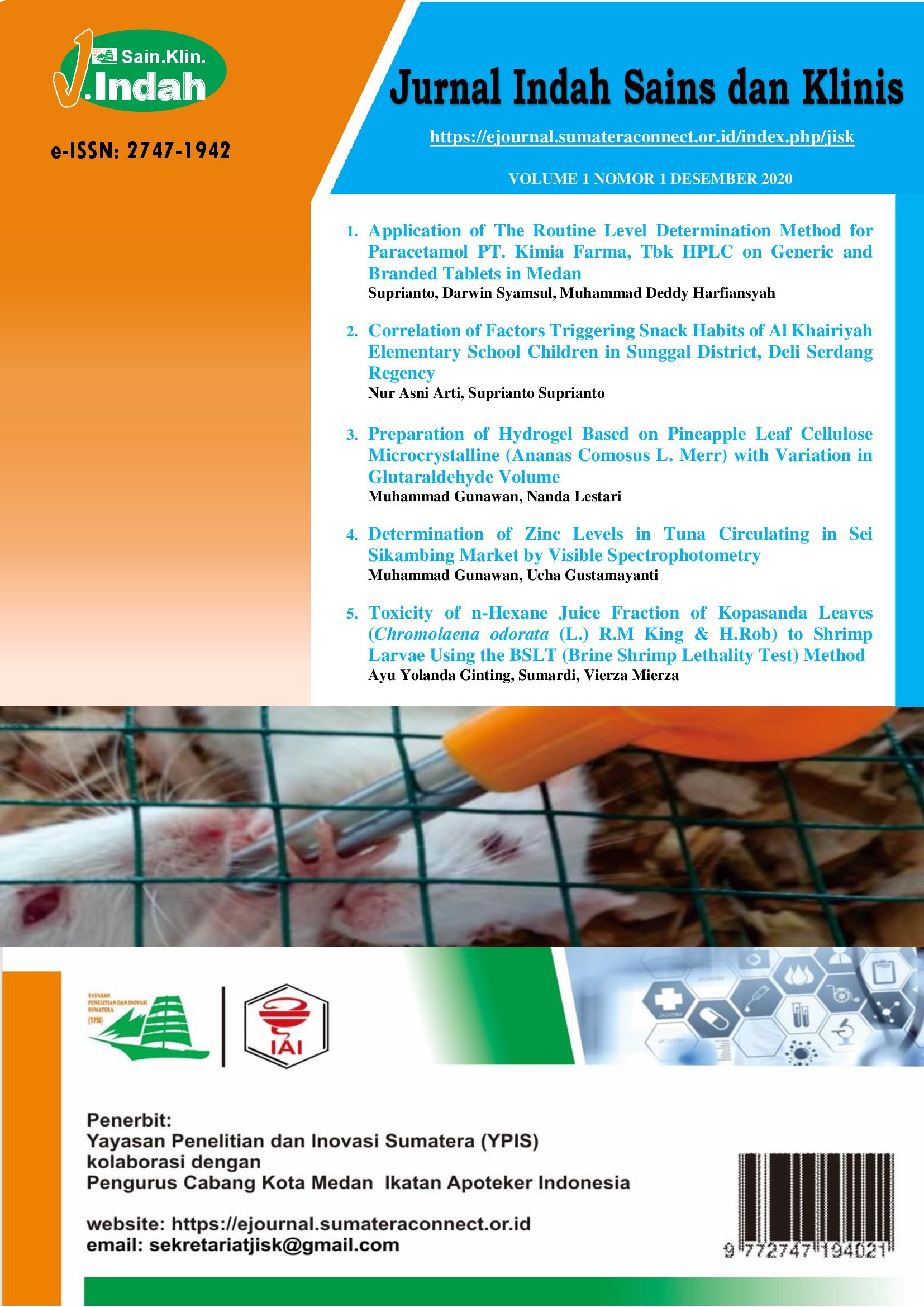Toxicity of nHexane Juice Fraction of Kopasanda Leaves (Chromolaena odorata (L.) R.M King and H.Rob) to Shrimp Larvae Using the BSLT (Brine Shrimp Lethality Test) Method
DOI:
https://doi.org/10.52622/jisk.v1i1.6Keywords:
Kopasanda (Chromolaena odorata), n-hexane fraction, polyphenol, toxicityAbstract
Kopasanda leaf plants (Chromolaena odorata (L.) R.M.King & H.Rob) are plants commonly used as medicinal ingredients empirically. The people of East Aceh use it as a wound medicine. Preliminary tests show that the extract and its partitions have a toxic effect on shrimp larvae. In this study, the soluble extract of n-hexane was fractionated using column chromatography with isocratic mobile phase n-hexane: ethyl acetate (7: 3) and silica gel stationary phase. Analysis of the chemical content profile using thin-layer chromatography showed that there were polyphenol organic compounds. The fraction 7 obtained shows that it is toxic to shrimp larvae of Artemia salina Leach.
Downloads
References
Absa, Nurfadilah. 2017. “Skrining Partisi-Partisi dan Fraksi-Fraksi Larut Etil Asetat dari Ekstrak Metanol Daun Botto-Botto (Chromolaena Odorata L.) Sebagai Anti Plasmodium.” Skripsi, Universitas Islam Negeri Alauddin Makassar.
Ajrina, Aulia. 2013. Uji Toksisitas Akut Ekstrak Metanol Daun Garcinia Benthami Pierre terhadap Larva Artemia Salina Leach dengan Metode Brine Shrimp Lethality Test (BSLT). Skripsi. Jakarta.
Andika, Bayu, Halimatussakdiah, and Ulil Amna. 2020. “Analisis Kualitatif Senyawa Metabolit Sekunder Ekstrak Daun Gulma Siam (Chromolaena Odorata L.) Di Kota Langsa, Aceh.” QUIMICA: Jurnal Kimia Sains Dan Terapan 2 (2): 1–6.
Day, Reuben Alexander, and Arthur Louis Underwood. 2002. Analisis Kimia Kuantitatif. Erlangga.
Fitrah, M, H Winarno, and P Simanjuntak. 2017. “Isolasi dan Identifikasi Senyawa Kimia Zat Anti Kanker dari Daun Kopasanda (Chromolaena Odorata (L.)).” Jurnal Ilmu Kefarmasian Indonesia 15 (1): 77–81.
Ifora, Helmi Arifin, and Rella Silvia. 2017. “Efek Antiinflamasi Krim Ekstrak Etanol Daun Kirinyuh (Chromolaena Odorata (L) RM King & H. Rob) secara Topikal dan Penentuan Jumlah Sel Leukosit pada Mencit Putih Jantan.” Jurnal Farmasi Higea 9 (1): 68–75.
Ikewuchi, Jude C, Catherine C Ikewuchi, Emeke C Enuneku, Stella A Ihunwo, Osazee I Osayande, Damiete B Batubo, and Damieibi I D Manuel. 2012. “Alteration of Blood Pressure Indices and Pulse Rates by an Aqueous Extract of the Leaves of Chromolaena Odorata (L) King and Robinson (Asteraceae).” Pacific Journal of Science and Technology 13 (2): 348–58.
Inya-Agha, S I, B O Oguntimein, A Sofowora, and T V Benjamin. 1987. “Phytochemical and Antibacterial Studies on the Essential Oil of Eupatorium Odoratum.” International Journal of Crude Drug Research 25 (1): 49–52.
Jumain, Syahruni, and Farid. 2018. “Uji Toksisitas Akut dan LD50 Ekstrak Etanol Daun Kirinyuh (Euphatorium Odoratum Linn) pada Mencit (Mus Musculus).” Media Farmasi 14 (1): 28–34.
Mukhriani, Andi Armisman Edy, Muh Fitrah Ilyas, and Dwi Wahyuni Leboe. 2017. “Analisis Efektivitas Daun Botto-Botto (Chromolaena Odorata L) terhadap Artemia Salina Leach yang Berpotensi sebagai Agen Antikanker.” Jurnal Farmasi UIN Alauddin Makassar 4 (1): 28–35.
Mutia, Dita. 2010. “Uji Toksisitas Akut Ekstrak Etanol Buah Anggur (Vitis Vinifera) Terhadap Larva Artemia Salina Leach dengan Metode Brine Shrimp Lethality Test (Bst).” Skripsi, Universitas Diponegoro.
Ngozi, Igboh M, Ikewuchi C Jude, and Ikewuchi C Catherine. 2009. “Chemical Profile of Chromolaena Odorata L.(King and Robinson) Leaves.” Pakistan Journal of Nutrition 8 (5): 521–24.
Ningdyah, Arimbi Wahyu, Andi Hairil Alimuddin, and Afghani Jayuska. 2015. “Uji Toksisitas dengan Metode BSLT (Brine Shrimp Lethality Test) terhadap Hasil Fraksinasi Ekstrak Kulit Buah Tampoi (Baccaurea Macrocarpa).” Jurnal Kimia Khatulistiwa 4 (1): 75–83.
Olowa, Lilybeth F, and Olga M Nuñeza. 2013. “Brine Shrimp Lethality Assay of the Ethanolic Extracts of Three Selected Species of Medicinal Plants from Iligan City, Philippines.” International Research Journal of Biological Sciences 2 (11): 74–77.
Rusli, Rachmat Kosman, and Pina Melinda. 2020. “Penelusuran Fungsi Endofit pada Daun Kopasanda (Chromolaena Odorata L.) yang Berpotensi sebagai Penghasil Antibakteri terhadap Bateri Penyebab Infeksi Kulit.” As-Syifaa Jurnal Farmasi 12 (1): 64–69.
Saputra, Ajmi, Abdul Gani, and Erlidawati Erlidawati. 2017. “Uji Aktivitas Antioksidan Daun Gulma Siam (Chromoleana Odorata L.) dengan Metode 1,1-Difenil-2-Pikrilhidrazil.” Jurnal IPA & Pembelajaran IPA 1 (2): 131–42. https://doi.org/10.24815/jipi.v1i2.9687.
Sumardi, Dadang Irfan Husori, Taufit Julianto, Raihanil Fauza, and Edita Eliska. 2018. “Toksisitas Ekstrak Daun Kopasanda (Chromolaena Odorata) terhadap Larva Artemia Salina Leach.” NERSMID: Jurnal Keperawatan dan Kebidanan 1 (1): 58–65.
Yenti, Revi, Ria Afrianti, and Linda Afriani. 2011. “Formulasi Krim Ekstrak Etanol Daun Kirinyuh (Euphatorium Odoratum. L) untuk Penyembuhan Luka.” Majalah Kesehatan PharmaMedika 3 (1): 227–30.
Downloads
Published
Issue
Section
License
Copyright (c) 2024 Jurnal Indah Sains dan Klinis

This work is licensed under a Creative Commons Attribution-NonCommercial-ShareAlike 4.0 International License.









 This work is licensed under a
This work is licensed under a 
